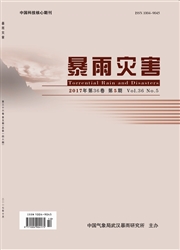

 中文摘要:
中文摘要:
基于上海暴雨积水110报警数据和自动气象站逐小时降水数据,利用时空过程分析法研究了暴雨积水与降水强度以及累积雨量的关系,建立了中心城区暴雨内涝的阈值指标,结果表明,中心城区暴雨积水程度与1 h降水强度和2 h累积雨量密切相关。当降水强度达30-40 mm·h-1时,中心城区就会出现暴雨积水。当降水强度达50 mm·h-1、2 h累积雨量达70 mm时,暴雨积水会明显增多。相对于暴雨发生的时间,暴雨积水具有明显的滞后效应,一般滞后1-2 h。下垫面状况、人口和道路密度也影响到暴雨积水的发生。综合海拔高程、下垫面类型、排水管网等多因素,开展中心城区精细化的暴雨内涝风险情景模拟及灾害损失评估,是下一步的研究方向。
 英文摘要:
英文摘要:
Based on rainstorm waterlogging data from 110 alarm centers and hourly rainfall data from automatic weather stations in Shanghai, the relationships between rainstorm waterlogging and rainfall intensity as well as cumulative rainfall were studied using the method of temporal and spatial process analysis. The rainstorm waterlogging threshold indicators in the urban areas of Shanghai were then established.The results show that the degree of waterlogging in the urban areas of Shanghai is closely associated with hourly rainfall intensity and 2-hour cumulative precipitation. Waterlogging would happen in the urban areas where the rainfall intensity reached 30-40 mm per hour, and waterlogging would increase significantly where rainfall intensity reached 50 mm per hour or 2-hour cumulative precipitation exceeded 70 mm.Compared to the occurrence time of rainstorm, rainstorm waterlogging has an obvious lagging effect with a lag of 1-2 hours in general. Moreover, underlying surface condition, density of population and road also play a role in the occurrence of rainstorm waterlogging. It is a future direction to develop risk scenario simulation and disaster loss assessment of rainstorm waterlogging with comprehensive consideration of the elevation, types of underlying surface, drainage networks and so on.
 同期刊论文项目
同期刊论文项目
 同项目期刊论文
同项目期刊论文
 期刊信息
期刊信息
